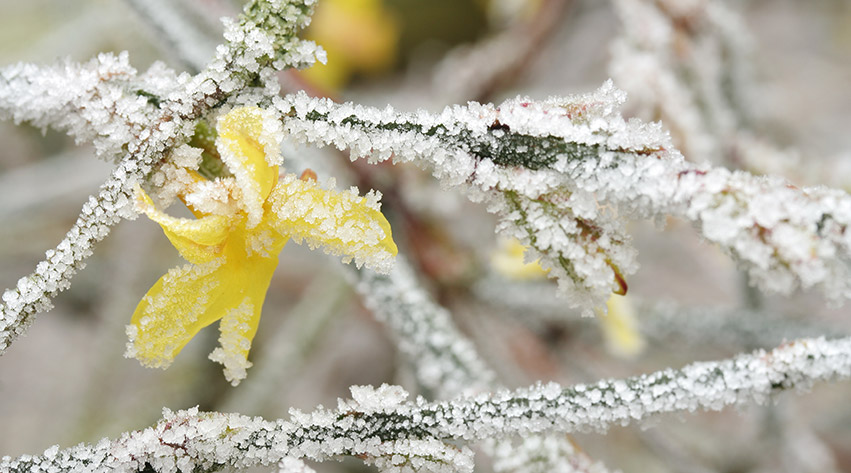Set your garden for the season
There are certain measures and preparations that you can take to give your garden the best chance of coming through a period of hard weather:
- Do not over feed your borders in autumn and use a balanced general fertiliser rather than one that is high in nitrogen.
- Do not prune plants too hard in autumn. It is better to leave extra growth on the plants until spring when they can be tidied up. This will act as some protection, meaning that although tips may be killed, the plant may stay alive lower down.
- Apply mulch to your borders in early autumn. This will give extra insulation to the soil and also protect the crowns of herbaceous perennials.
- Take soft wood cuttings of tender plants such as Salvia, Gazania and Penstemon towards the end of the summer and over winter in a frost free environment.
- Round up any empty containers and store them in a frost free environment until they are needed next spring.
- Make sure that you have a supply of rock salt to spread on paths that you use regularly.
- Do not over feed evergreen plants in autumn – this will encourage evergreens to put on soft growth that may be harmed during a cold ‘snap’.
Protecting plants
- Many evergreens have a mechanism that makes their leaves droop in very cold weather. This helps the plant to shed snow and prevents branches being broken if it should build up. Wrap tender evergreens such as Cordyline Australis and Tree Ferns by surrounding them with a layer of dry straw or bracken. Wrap the plant and straw in horticultural fleece tied at intervals with string to prevent it blowing away or rubbing the plant.
- Upright growing evergreens such as Conifers and clipped Box should have their branches tied together during the winter to prevent snow from breaking them or bending them out of shape.
- Lying snow can be gently knocked off plants with a broom or bamboo cane to prevent the branches from being broken or bent out of shape.
- Plants grown permanently in large containers are more vulnerable to freezing conditions, especially if they are evergreen. This is because the pot can freeze up and the plant can no longer take up the water it needs to replace what is being lost through its leaves.
- Move half hardy plants to a greenhouse that can be heated if need be – these plants are unlikely to survive much harder weather if they are left outside.
- Move hardy evergreens to a cold greenhouse if you have room. If you do not have a greenhouse, move containers to a sheltered part of the garden, preferably near a house wall where they will get some reflected heat.
- Group the containers together for extra protection. Wrap the pots in bubble wrap to give the roots extra insulation. Wrap evergreens with horticultural fleece to cut down on water loss through the leaves.
- Monitor your evergreens and water if necessary – they can dry out quickly during windy weather.
- Raise pots containing deciduous plants onto pot feet or bricks if the weather is wet, to help with drainage.
- Tender plants in the ground should be dug up, potted into large containers and moved to a greenhouse that can be heated if need be. However, many may survive if they are given some protection. Leave old growth on tender plants through the winter as extra protection. This can be removed next spring once the weather warms up.
- Newly planted evergreens are susceptible to ‘drying out’ during freezing weather – even those that are perfectly hardy once they are established in the ground. Erect a windbreak around newly planted evergreens that were put in during the autumn. Make sure that they do not go short of water during dry, windy spells.
Protecting buildings
- If you have a greenhouse or poly tunnel check to make sure there are no cracked panes of glass or rips in polythene. Heavy falls of snow can make this worse. Any lying snow should be cleared from these as soon as possible to prevent the structures from buckling under the weight.
- Replace torn felt on shed roofs to ensure that your shed stays dry when snow melts.
- Make sure that you have adequate supplies of paraffin for your greenhouse heater!
Protecting ponds and birdbaths
Use a pond heater to stop the water from freezing if you have fish. Placing a tennis ball in your birdbath may prevent the water from freezing but remember to supply fresh water each day, along with food during snowy weather.
Remember!
Snow is not always a bad thing for your garden. Many pests are killed by a spell of hard weather and lying snow insulates plants against freezing winds. Many plants are held in a state of suspended animation through the winter months and will almost always grow away in the spring once the temperature rises.



